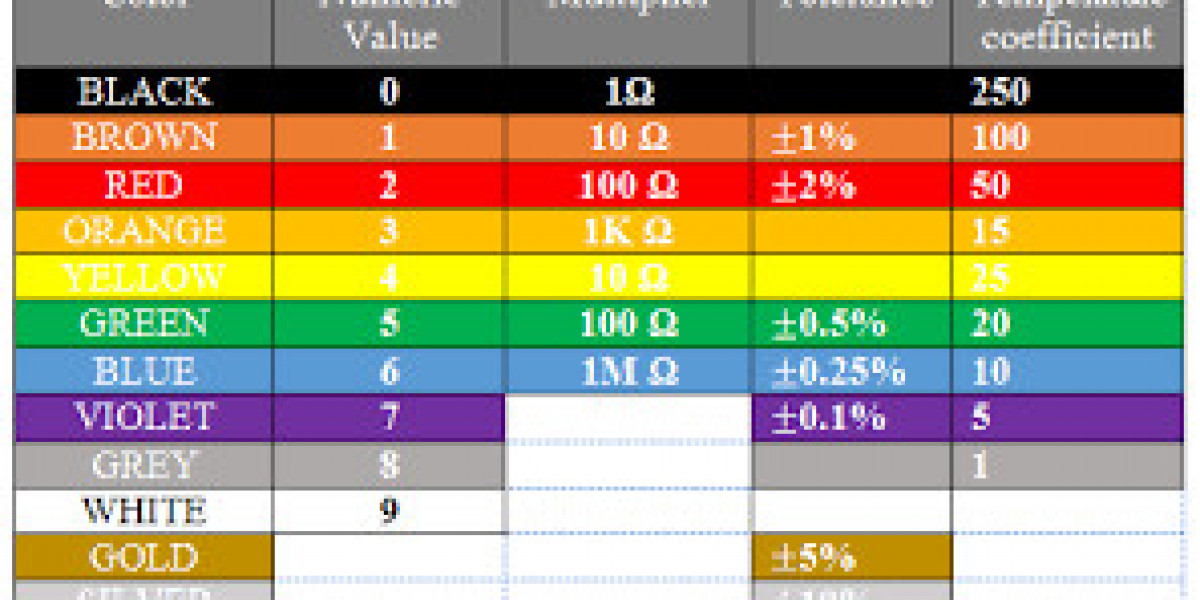Resistors are one of the most common components found in almost every electronic circuit. They control the flow of electric current, divide voltages, and protect sensitive components from excessive current. But have you ever looked closely at a resistor and noticed the colored bands around it? Those colors are not random — they are part of a standardized system known as the Resistor Color Code. This color code allows engineers, technicians, and hobbyists to quickly identify the resistance value of a resistor without using a measuring device.
In this article by Origin-IC, we’ll explain the concept of color code resistors, how to read them, what the colors represent, and why this system remains crucial in electronics today.
What is a Color Code Resistor?
A color code resistor uses colored bands printed on its body to indicate its resistance value, tolerance, and sometimes its reliability or temperature coefficient. This method was created because writing small numerical values directly on resistors is impractical due to their tiny size.
Each color corresponds to a specific number, multiplier, and tolerance value. The color bands are read from left to right, and depending on the type, a resistor can have four, five, or six bands.
Why the Color Code System Was Introduced
Before modern printing and labeling techniques, manufacturers needed a simple and durable way to mark resistors. Paint or ink could fade or rub off easily. The color band system provided a universal, easy-to-read, and durable method to encode information directly onto the component.
The system was standardized by the Electronics Industries Association (EIA) and later adopted internationally. Over time, this coding system became the global standard, ensuring that resistors made anywhere in the world could be identified in the same way.
The Standard Resistor Color Code Chart
Below is the standard chart used to decode resistor color bands:
| Color | Digit | Multiplier (Ω) | Tolerance (%) |
|---|---|---|---|
| Black | 0 | 1 | — |
| Brown | 1 | 10 | ±1 |
| Red | 2 | 100 | ±2 |
| Orange | 3 | 1,000 | — |
| Yellow | 4 | 10,000 | — |
| Green | 5 | 100,000 | ±0.5 |
| Blue | 6 | 1,000,000 | ±0.25 |
| Violet | 7 | 10,000,000 | ±0.1 |
| Gray | 8 | 100,000,000 | ±0.05 |
| White | 9 | 1,000,000,000 | — |
| Gold | — | 0.1 | ±5 |
| Silver | — | 0.01 | ±10 |
| None | — | — | ±20 |
This chart is the foundation for color code resistor any resistor’s value using its color bands.
How to Read a 4-Band Resistor Color Code
Most common resistors have four color bands. Here’s how to interpret them:
First Band – Represents the first significant digit.
Second Band – Represents the second significant digit.
Third Band – Is the multiplier, meaning the power of 10 by which the first two digits are multiplied.
Fourth Band – Indicates tolerance (accuracy range).
Example:
A resistor with the color bands Red, Violet, Yellow, Gold
Red = 2
Violet = 7
Yellow = 10,000 (multiplier)
Gold = ±5% (tolerance)
So, the resistance value = 27 × 10,000 = 270,000 Ω or 270 kΩ ±5%
How to Read a 5-Band Resistor Color Code
Precision resistors often use five color bands to provide more accurate readings.
First Band – First digit
Second Band – Second digit
Third Band – Third digit
Fourth Band – Multiplier
Fifth Band – Tolerance
Example:
Color bands: Brown, Black, Black, Red, Brown
Brown = 1
Black = 0
Black = 0
Red = 100 multiplier
Brown = ±1% tolerance
Value = 100 × 100 = 10,000 Ω or 10 kΩ ±1%
6-Band Resistor Color Code
Some resistors include a sixth band, which represents the temperature coefficient — how much resistance changes with temperature. This is especially important for precision applications such as aerospace, medical, or instrumentation circuits.
For example:
Brown (1), Black (0), Black (0), Orange (1,000), Brown (±1%), and Red (50 ppm/°C).
This means 10 × 1,000 = 10,000 Ω ±1%, with a temperature coefficient of 50 ppm/°C.
Importance of Tolerance and Temperature Coefficient
Tolerance tells you how close the actual resistance is to the stated value. For example, a 100 Ω resistor with ±5% tolerance can range from 95 Ω to 105 Ω.
Temperature Coefficient indicates stability with temperature changes. A lower value means better stability — crucial for high-precision circuits.
Applications of Color Code Resistors
Resistors are everywhere — from simple circuits in toys to complex microprocessor systems. The color coding helps ensure proper functionality and prevents damage due to incorrect resistance values.
Some common applications include:
Voltage Division: Splitting voltage levels in circuits.
Current Limiting: Preventing excess current to protect components.
Signal Conditioning: Stabilizing input/output signals.
Timing Circuits: Used with capacitors to define time constants.
At Origin-IC, resistors are manufactured and tested under strict quality standards to ensure long-lasting performance and precision, making them suitable for both industrial and educational purposes.
Tips for Reading Color Codes Accurately
Hold the resistor correctly: The tolerance band (usually gold or silver) should be on the right side.
Use good lighting: Colors like red and orange or blue and violet can look similar under poor lighting.
Double-check using a multimeter: This ensures your visual interpretation matches the actual resistance.
Practice regularly: The more resistors you decode, the faster you’ll recognize values.
Color Coding in Modern Times
While digital tools like multimeters and component testers are widely available, the resistor color code remains an essential skill for every electronics professional and student. It promotes quick identification and helps when testing or repairing circuits without advanced tools.
Companies like Origin-IC continue to follow this standard in their resistor manufacturing to maintain compatibility with global electronic design and educational systems.
Conclusion
Understanding the color code resistor system is a foundational skill for anyone involved in electronics. It’s a clever and efficient way to represent resistor values, making it easy to identify components quickly.
Whether you are an engineer designing a new product, a student learning electronics, or a technician repairing a circuit, knowing how to read color codes can save time and prevent costly mistakes.
At Origin-IC, we believe in simplifying technology for everyone — and knowing the basics of resistor color codes is a great place to start. It connects the past and present of electronics, ensuring that even the smallest component speaks a universal language of precision and clarity.
| Follow ODG: |
| YouTube: https://www.youtube.com/@Origin_Data |
| Facebook: https://www.facebook.com/OriginDataGlobalLimited |
| Twitter: https://twitter.com/Origin_IC |
| Tiktok: https://www.tiktok.com/@origin_data |
| Szxlxc: https://www.szxlxc.com |







